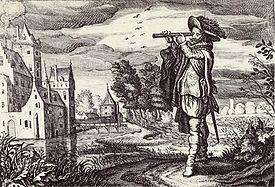
Back تاريخ المقراب Arabic Història del telescopi Catalan Historia del telescopio Spanish Teleskopioaren historia Basque Histoire du télescope French Storia dei telescopi Italian 망원경의 역사 Korean د تلسکوپ تاریخچه Pashto/Pushto Teleskobun tarihi Turkish Історія телескопа Ukrainian

The history of the telescope can be traced to before the invention of the earliest known telescope, which appeared in 1608 in the Netherlands, when a patent was submitted by Hans Lippershey, an eyeglass maker. Although Lippershey did not receive his patent, news of the invention soon spread across Europe. The design of these early refracting telescopes consisted of a convex objective lens and a concave eyepiece. Galileo improved on this design the following year and applied it to astronomy. In 1611, Johannes Kepler described how a far more useful telescope could be made with a convex objective lens and a convex eyepiece lens. By 1655, astronomers such as Christiaan Huygens were building powerful but unwieldy Keplerian telescopes with compound eyepieces.[1]
Isaac Newton is credited with building the first reflector in 1668 with a design that incorporated a small flat diagonal mirror to reflect the light to an eyepiece mounted on the side of the telescope. Laurent Cassegrain in 1672 described the design of a reflector with a small convex secondary mirror to reflect light through a central hole in the main mirror.
The achromatic lens, which greatly reduced color aberrations in objective lenses and allowed for shorter and more functional telescopes, first appeared in a 1733 telescope made by Chester Moore Hall, who did not publicize it. John Dollond learned of Hall's invention[2][3] and began producing telescopes using it in commercial quantities, starting in 1758.
Important developments in reflecting telescopes were John Hadley's production of larger paraboloidal mirrors in 1721; the process of silvering glass mirrors introduced by Léon Foucault in 1857;[4] and the adoption of long-lasting aluminized coatings on reflector mirrors in 1932.[5] The Ritchey-Chretien variant of Cassegrain reflector was invented around 1910, but not widely adopted until after 1950; many modern telescopes including the Hubble Space Telescope use this design, which gives a wider field of view than a classic Cassegrain.
During the period 1850–1900, reflectors suffered from problems with speculum metal mirrors, and a considerable number of "Great Refractors" were built from 60 cm to 1 metre aperture, culminating in the Yerkes Observatory refractor in 1897; however, starting from the early 1900s a series of ever-larger reflectors with glass mirrors were built, including the Mount Wilson 60-inch (1.5 metre), the 100-inch (2.5 metre) Hooker Telescope (1917) and the 200-inch (5 metre) Hale Telescope (1948); essentially all major research telescopes since 1900 have been reflectors. A number of 4-metre class (160 inch) telescopes were built on superior higher altitude sites including Hawaii and the Chilean desert in the 1975–1985 era. The development of the computer-controlled alt-azimuth mount in the 1970s and active optics in the 1980s enabled a new generation of even larger telescopes, starting with the 10-metre (400 inch) Keck telescopes in 1993/1996, and a number of 8-metre telescopes including the ESO Very Large Telescope, Gemini Observatory and Subaru Telescope.
The era of radio telescopes (along with radio astronomy) was born with Karl Guthe Jansky's serendipitous discovery of an astronomical radio source in 1931. Many types of telescopes were developed in the 20th century for a wide range of wavelengths from radio to gamma-rays. The development of space observatories after 1960 allowed access to several bands impossible to observe from the ground, including X-rays and longer wavelength infrared bands.
- ^ The history of the telescope Henry C. King, Harold Spencer Jones Publisher Courier Dover Publications ISBN 0-486-43265-3, ISBN 978-0-486-43265-6
- ^ Lovell, D. J.; 'Optical anecdotes', pp.40-41
- ^ Wilson, Ray N.; 'Reflecting Telescope Optics: Basic design theory and its historical development', p.14
- ^ "Inventor Biographies – Jean-Bernard-Léon Foucault Biography (1819–1868)". madehow.com. Retrieved 2013-08-01.
- ^ "Bakich sample pages Chapter 2" (PDF). p. 3. Retrieved 2013-08-01.
John Donavan Strong, a young physicist at the California Institute of Technology, was one of the first to coat a mirror with aluminum. He did it by thermal vacuum evaporation. The first mirror he aluminized, in 1932, is the earliest known example of a telescope mirror coated by this technique.
© MMXXIII Rich X Search. We shall prevail. All rights reserved. Rich X Search